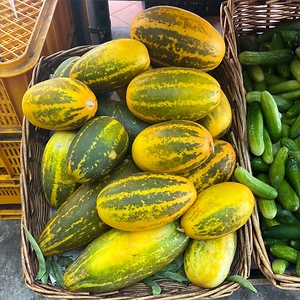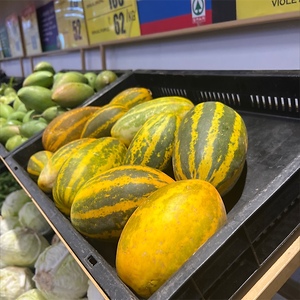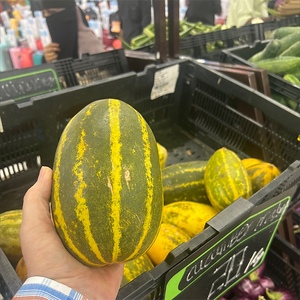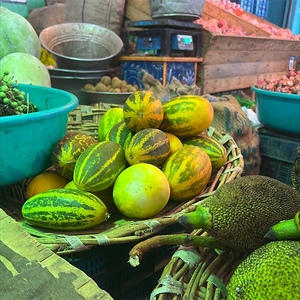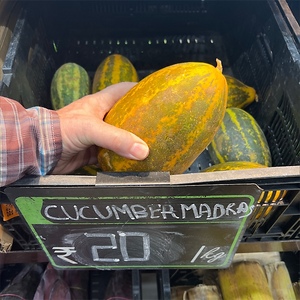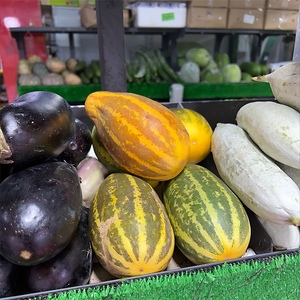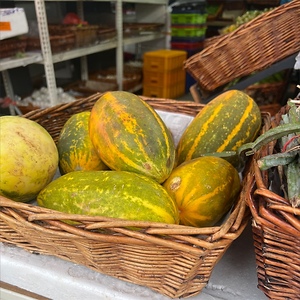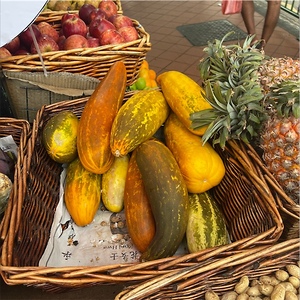


Malabar Cucumbers
Estimated Inventory, ea : 0
Description/Taste
Malabar cucumbers are a medium to large varietal, averaging 10 to 20 centimeters in length and 7 to 15 centimeters in diameter, and have an elongated, cylindrical shape with one tapered, pointed end and one curved blunt end. When young, the cucumber’s skin is smooth, taut, and firm with a light green to yellow base, covered in dark green broken striping. As the cucumbers mature, their skin becomes tough, and the coloring transforms into a golden yellow hue with a vibrant burnt orange striping. The off-white to cream-colored flesh is aqueous, crisp, and crunchy, encasing a central cavity filled with ivory tear-drop-shaped seeds suspended in a gelatinous liquid. These small seeds are edible but carry a bitter taste, leading many consumers to discard them before eating the cucumber. Malabar cucumbers are primarily cooked and contribute a crunchy and watery texture with a mild, vegetal, and subtly floral flavor.
Seasons/Availability
Malabar cucumbers are available year-round, with a peak season in the summer.
Current Facts
Malabar cucumbers, botanically classified as Cucumis maderaspatensis, are an Indian variety belonging to the Cucurbitaceae family. The unusual striped cucumbers grow on a creeping vine and thrive in southern India, where they are a common ingredient sold in local markets. Malabar cucumbers are known by many regional names, including Madras, Mangalore, Sambar, Dosakaya, Indian Yellow cucumber, Ayileyam, Kottirikai, and Curecuvari in Tamil, Agagmukhi in Bengali, and Cenkummatti in Malayalam. Unlike other cucumber varieties, Malabar cucumbers are traditionally consumed cooked and are favored for their firm, crunchy texture. In India, Malabar cucumbers are a common home garden cultivar as they are fast-growing and mature on the vine within two weeks. Malabar cucumbers are versatile and can be harvested when they are green, young, and firm, or they can be left to mature and are harvested when orange, soft, and slightly crunchy.
Nutritional Value
Malabar cucumbers contain vitamin A to maintain healthy organ functioning, vitamin C to strengthen the immune system, and vitamin E to reduce inflammation. The cucumbers also contain antioxidants to protect the cells against free radical damage and minerals such as magnesium, phosphorous, and potassium. In India, cucumbers are viewed as a cooling food to reduce heat from the body and are consumed on warm days to soothe the throat and stomach.
Applications
Malabar cucumbers are rarely eaten raw and are preferably used in cooked preparations. Unlike common cucumbers, Malabar cucumbers hold their shape well when cooked and have a firm texture, adding crunch to dishes. The cucumbers are popularly simmered into curries, soups, and stews, mixed into stir-fries or diced into chutneys. In India, Malabar cucumbers are a staple ingredient in Karnataka, Tamil Nadu, and Andhra Pradesh cuisines and are a favored vegetable in sambar, a lentil-based stew. The cucumbers also have a neutral taste, absorbing accompanying flavors, allowing them to be used in vegetable, bean, or rice dishes, cooked into flour pancakes, or served as a side dish with raw mango and coconut. Beyond cooked preparations, Malabar cucumbers are favored for their slightly sour flavor, fermented in salt, water, and spices to make tangy pickles. One popular type of pickle, known as dosakaya, is coated in a mixture of garlic, lemon juice, mustard powder, red chili powder, and methi seeds. Malabar cucumbers pair well with tamarind, aromatics such as garlic, onions, chiles, and ginger, coconut, mango, and spices including cumin, turmeric, and curry powder. Malabar cucumbers will keep for a couple of weeks, depending on maturity, when stored unwashed in a perforated bag in the refrigerator.
Ethnic/Cultural Info
Malabar cucumbers contain edible seeds, but most consumers separate the seeds from the flesh for culinary preparations. The seeds are known for having a slightly bitter nature, adding unwanted flavors to dishes. Despite their bitterness, cucumber seeds are valued in southern India for their medicinal uses. Malabar cucumber seeds are rich in vitamins, minerals, and antioxidants. The seeds contain vitamin E to reduce inflammation and potassium to balance fluid levels within the body. Cucumber seeds are also seen as anti-aging, helping to improve skin complexion and reduce the damage caused by environmental factors.
Geography/History
Malabar cucumbers are native to India. Much of the variety’s history is unknown, but experts believe they may have been native to the Madras region, a province that existed under British reign, consisting of Kerala, Tamil Nadu, Karnataka, and Andhra Pradesh. Malabar cucumbers have been utilized as a culinary ingredient in India since ancient times, as recorded in Indian texts that pre-date the arrival of the British. Over time, the cucumbers were also spread to neighboring countries in Asia and Southeast Asia through trade routes and migrating peoples. Today Malabar cucumbers are cultivated through select growers in India and are grown in home gardens for local sale. When in season, the cucumbers can be found in India, China, Myanmar, Nepal, Pakistan, Sri Lanka, and Bhutan.
Recipe Ideas
Recipes that include Malabar Cucumbers. One
| NDTV Food |
|
Malabar Cucumber Relish with Peanuts |
| The Pepper Spoon |
|
Malabar Cucumber Curry |
| Konkani Cook Book |
|
Malabar cucumber stir fry |







